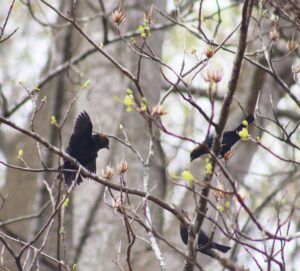by Jacob Crider
Late Autumn and early winter time is the perfect time to collect native seeds for home gardens, natural areas projects, and nurseries. After a long summer of flowering and pollination, many of our native perennial and annual trees, shrubs, grasses and wildflowers are setting seed to be dispersed this winter, and will germinate this following spring once warm temperatures and moist conditions return.
While native seeds can be collected throughout winter, it is optimal to find your seeds earlier on in the season before natural weather processes such as rain, wind and freezing temperatures scatter them throughout the landscape. Of course these processes are part of the natural dispersal of these seeds, but for folks gathering it sure is difficult to find them anywhere once they have been removed off the plant in some fashion or another.
The vast majority of seeds in the Eastern U.S and in other temperate climates around the world require stratification in order to germinate and grow into mature plants. Stratification is a required cold period seeds must go through in order to pop up in spring following winter. If these plants did not develop this process, a seed may grow on a warm day in the middle of winter, and subsequently die during freezing temperatures that usually follow. This germination mechanism has allowed for temperate plants to successfully grow and survive winter seasons throughout their native ranges.
Some seeds such as Kentucky Coffee beans, honey locust, Partridge Pea and Bladdernut have an additional germination requirement known as scarification. This process involves the the exfoliation or dissolvement of the outer coating of a seed in order to germinate. This happens naturally when they are consumed by wildlife and are exposed to winter conditions. When consumed by wildlife, they are subjected to the acids and enzymes of the animals digestive system which slowly chips away at the seeds protective coating and then allows for them to grow. When seeds are consumed by wildlife, they are also dispersed amongst the landscape.
Native seeds can be stratified and scarified by humans as well. If you want to successfully cultivate many of our native plants, you can plants seeds outdoors in fall and winter to have them stratify naturally, or you can wait to plant until spring and stratify them in your refrigerator. When utilizing the “fridge method” any where between 6-10 weeks is optimal, with some seeds preferring 12 weeks and others only needing 2-4. If scarification is needed, an acid bath can be used, tough sandpaper can be applied, or seeds can be boiled and left in water for 48 hours, just as long as that outer coating is given a good “roughing up.”
Seed collecting is an enjoyable and fun activity in winter time for fam airlines and individuals and can be a opportunity to learn more about the plants we know and love, and to help establish native plant communities in our neighborhoods, parks, and natural areas. Be sure to only collect about 10% of what you find, and if a plant is scarce in an area, waive the collection of those seeds until a bigger patch is found.
Happy Seed Collecting!




